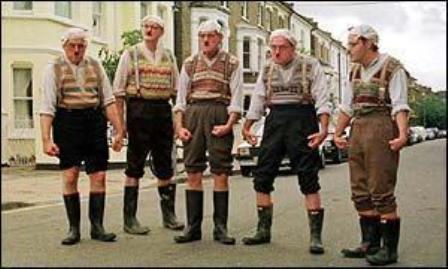
“The show, unabashed in its silliness, frequently broke the fourth wall and even mocked its own format with characters who would openly interrupt and derail sketches.” — Zoë DiGiorgio
When people think of British humor, they might associate it with instantly identifiable dry wit and deadpan delivery. Though these are expected features of British comedies, the Brits have also given the world some of the most important contributions to surrealist comedy, and plain old silliness.
Enter Monty Python, one of the most famous absurdist British comedy troupes. The group is so central to left-field, non sequitur comedy that the term “Pythonesque” came to describe the troupe’s particular brand of comedy.
Started back in the 1960s, Monty Python assembled some of Britain’s best comedic minds — Michael Palin, Eric Idle, Graham Chapman, Terry Jones, John Cleese and American-born Terry Gilliam — and brought them into living rooms across Great Britain. Their TV series, Monty Python’s Flying Circus, produced some truly iconic pieces of surreal sketch comedy while also influencing some of the biggest names in comedy today.
Running for four seasons between 1969 and 1974, the show followed a rather different format than modern American sketch comedy shows such as Saturday Night Live. Inspired by the groundbreaking comedy series Q5 by Spike Milligan, the episodes followed a stream-of-consciousness format punctuated by a series of bizarre animations provided by Gilliam. The show, unabashed in its silliness, frequently broke the fourth wall and even mocked its own format with characters who would openly interrupt and derail sketches. The show lampooned everything from trivial idiosyncrasies of British life to historical events such as the Spanish Inquisition.
The series produced some truly timeless skits, including those involving a man who bought a dead parrot trying to return it to the pet store, a man trying to sell an albatross in a theater, the ministry of silly walks and the ever-catchy lumberjack song, among many others.
After the end of Flying Circus, the troupe went on to produce several full-length films, including the loving-yet-bizzare spoof of the King Arthur myth, Monty Python and the Holy Grail, as well as And Now for Something Completely Different, a longer collection of previously unaired short sketches. Later movies followed, including the highly controversial religious satire The Life of Brian in 1979 and The Meaning of Life in 1983. In 2004, a sort of Monty Python’s greatest hits collection was brought to Broadway in the wildly successful self-parodying musical Monty Python’s Spamalot, a stage adaptation of Holy Grail.
Today, many modern comedians cite the Pythons as a source of inspiration. Echoes of “Pythonesque” humor can be seen in shows such as the British comedy sketch series A Bit of Frye and Laurie, as well as American shows such as South Park, The Simpsons and The Daily Show and in comedy troupes such as “The Whitest Kids U’ Know.”
Longtime Saturday Night Live cast member and star of the Austin Powers films Mike Myers even said, “If comedy had a periodic element table, Python would have more than one atom on it.”
Though its comedy flip-flops between the bizarre and the cerebral, Monty Python has withstood the test of time and lived on in a generation of actors, writers and comedians who know how to embrace their silliness.
[ READ MORE: The weird, wonderful world of absurdist comedy ]



